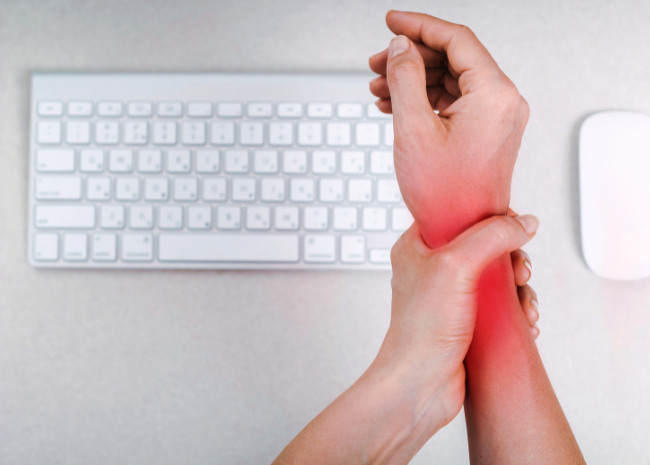
The Light at the End of the Carpal Tunnel
What is Carpal Tunnel Syndrome?
Carpal tunnel syndrome (CTS) affects as many as one in 20 Americans.
It occurs when the median nerve—the nerve that controls movement and sensation in the palm of the hand, thumb, and fingers—is compressed as it travels through the carpal tunnel.
This tunnel is a narrow passageway in the wrist formed by bones on the bottom and sides, along with a ligament that forms the top of the tunnel.
Causes and Risk Factors
The median nerve shares the carpal tunnel with several tendons.
If these tendons become swollen due to extensive finger use and wrist flexion, the compressed median nerve may cause a feeling of numbness or “pins and needles” in the fingers and wrist.
Given the prevalence of technology and the strong impact that excessive keyboard and computer use can have on the median nerve, the incidence of CTS is likely to increase.
– CTS is common in professions such as:
- Assembly-line work
- Jobs requiring the use of hand tools, especially those that vibrate
– Some leisure activities that can also cause CTS include:
- Sewing
- Sports such as racquetball and handball
- Playing string instruments such as the violin
What Triggers Carpal Tunnel Syndrome?
Here’s a list of common triggers for Carpal Tunnel Syndrome:
- Extended Computer Use: Typing for long periods, especially with poor wrist posture.
- Repetitive Hand Movements: Activities like knitting or assembly-line work.
- Vibrating Tools: Using hand tools that produce vibration, such as power drills.
- Improper Wrist Position: Keeping wrists bent or in awkward positions during various activities.
- Frequent Use of Handheld Devices: Constant use of smartphones or tablets.
- Certain Sports: Activities like racquetball or handball that involve repetitive wrist movements.
- Playing Musical Instruments: Playing instruments like the violin or guitar with improper technique.
Q: Can I heal carpal tunnel on my own?
Yes, it’s possible to manage and improve carpal tunnel syndrome on your own, especially if the symptoms are mild.
- Start by making some changes to your daily habits, like improving your posture and taking regular breaks from repetitive activities.
- Wearing a wrist splint at night can also help keep your wrist in a neutral position and reduce pressure on the median nerve.
- Incorporating stretching and strengthening exercises for your wrist and hand may provide relief.
However, if your symptoms persist or worsen, it’s a good idea to consult a healthcare professional.
They can offer more personalized advice and treatment options to ensure you get the best care.
Treatment Options
Posture and Lifestyle Changes
One of the most basic treatment options for CTS involves making changes in posture.
Because all your joints are linked, improving overall body posture will help keep your hands and wrists properly aligned.
- Avoid keeping your wrists bent unnecessarily.
- Take regular “stretch breaks” during your daily routines to keep your joints limber.
- Sleeping with a night splint can help reduce symptoms while training your wrist muscles to align properly.
Consultation and Surgery
Before making major changes or considering surgery, start with a thorough consultation with a physical therapist.
- Our PTs will assess your symptoms and create a personalized treatment plan, which may include lifestyle adjustments and physical therapy.
- If these methods don’t provide relief, surgery might be an option to relieve severe pressure on the median nerve.
- After surgery, physical therapy is crucial for restoring strength and flexibility in your wrist.
Our goal is to guide you through every step, ensuring you have the support and information needed for a successful recovery.
Physical Therapy Interventions
Physical therapy can play a crucial role in treating carpal tunnel syndrome (CTS) and helping you regain comfort and function.
We can design a tailored therapy plan that includes several effective techniques:
- Gliding Exercises: These exercises involve moving your fingers and hands through specific patterns to help the tendons and nerves glide smoothly within the carpal tunnel. By doing so, we aim to reduce nerve compression and improve overall wrist flexibility.
- Manual Therapy: This hands-on approach targets tight tendons and muscles in the wrist and forearm. Through techniques like stretching and deep tissue massage, manual therapy helps to release tension and improve blood flow, which can alleviate pain and enhance wrist function.
- Splinting: Wearing a splint can help immobilize the wrist, keeping it in a neutral position to relieve pressure on the median nerve. This support is especially beneficial during activities that exacerbate your symptoms and while you sleep, to prevent overnight worsening of your condition.
These interventions, when combined, can significantly reduce CTS symptoms and help you return to your daily activities with greater ease and comfort.
Our goal is to provide you with a comprehensive approach to manage your condition and improve your quality of life.
Did you know you have Direct Access* to Physical Therapy? No referral, no problem!
Get Started Today
Physical therapy is a key part of the recovery process.
Our physical therapists at The Jackson Clinics can create a personalized program to help you avoid further injury and improve your condition.
Get started today to start feeling better and reclaiming your life.
The Jackson Clinics serves 18 locations throughout Northern Virginia.
Find one near you: https://thejacksonclinics.com/locations/










